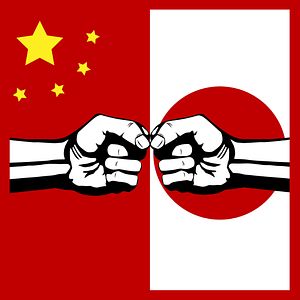Hard power is the predominant realist mode of measuring power, relative and absolute. We measure military and economic capabilities and draw conclusions about a given state’s ability to seek the outcomes it desires from other political actors – friend or foe. Generally, this is a useful model for thinking about states’ options and underlies a good deal of contemporary analysis in international security. In East Asia, hard power distributions, buttressed by U.S. alliance networks (particularly with South Korea and Japan), have kept conflict at bay, despite widespread mistrust and resentment (between U.S. allies and China).
In the East Asian security equation, there seems to be little interest in challenging the tense current status quo. Using the East China Sea dispute over the Diaoyu/Senkaku islands as a case in point, it is evident that the stand off between China and Japan shows no signs of drawing down due to third-party mediation, international arbitration, bilateral diplomacy, or unilateral capitulation. While current trends are subject to change with a unilateral policy revision by either China or Japan, the probability of a skirmish – or indeed war – is not remote.
Much has been said of China’s approach to the dispute – especially recently following its decision to unilaterally declare an Air Defense Identification Zone (ADIZ) over a large swathe of the East China Sea, claiming airspace over the disputed islets in the process. What is remarkable about the escalation over the islets, which really came to the fore of the mainstream media after a Chinese fishing boat collided with a Japanese Coast Guard patrol in 2010, is that so far we’ve seen hard power brinksmanship almost exclusively. Neither China nor Japan – both relatively mature international actors – have taken steps outside this rubric to address the dispute.
Most visibly, soft power is almost entirely absent from the Beijing-Tokyo relationship today. If there were some soft power coefficient to describe the rate at which perceptions between the two countries are changing, it would be a negative number. Opinion surveys show that perceptions that close to nine in ten Chinese feel negatively about Japan, and eight in ten Japanese harbor negative sentiments towards China.
Back in 2007, when China’s “peaceful rise” rhetoric was in vogue in the Hu-Wen era, certain analysts of Chinese affairs grew optimistic at Hu Jintao’s declaration that China would pursue “soft power” globally – that Hu proclaimed this in his keynote speech to the 17th National Congress of the Communist Party of China suggested that as China rose, it might escape the Thucydidean trap in East Asia.
One of Hu’s dictums on soft power was that the CPC ought to “step up the development of the press, publishing, radio, film, television, literature and art, give correct guidance to the public and foster healthy social trends.” Today, the CPC conditions Chinese journalists to broach the issue of China-Japan relations and the Senkaku/Diaoyu dispute within an ideologically prescribed rubric, intended to fan nationalist sentiment against Japan.
In general, there seem to be no serious attempts by either China or Japan to improve mutual perceptions. If Japan was trying to elect a Prime Minister who would be most likely to provoke China on contentious historical issues, it certainly succeeded with the election of Shinzo Abe. Continued visits to Yasukuni shrine, among other slights, will remain deleterious to Japanese soft power towards China.
Soft power’s progenitor, Joseph S. Nye, conceived it as the ability to influence the behavior of another state through non-hard power means – encompassing culture, values, and ideology. Despite its heterodox allure compared to brutish realist concerns about hard power distributions, it does have its limitations. China in the Xi-Li era seems to have recognized that while a Chinese pursuit of soft power globally might be worthwhile, only calculated realist maneuvering will protect Chinese interests in East Asia – not only vis-a-vis Japan, but also in the South China Sea. As Minxin Pei wrote recently on the ADIZ, the “peaceful rise” meme seems to have been tossed out the window.
Japan, in contrast to China, is a top performer when it comes to soft power. Monocle rated Japan as sixth globally in its 2012 soft power survey. It just doesn’t seem to be able to exercise the benefits of being a soft power virtuoso regionally.
China also has strong incentives to not channel its soft power energies towards Japan. The CPC perceives that fanning mainland Chinese nationalism against Japan has the potential to stave off any legitimacy crises for the government in the short-term. As Thomas Christensen has written, “Chinese policymakers are hypersensitive to nationalist criticism at home and more rigid – at times even arrogant – in response to perceived challenges abroad.” This has led to a situation where the only acceptable mode of criticism within China of the party and of Chinese foreign policy emerges from a nationalist angle.
If perceptions improved between China and Japan, one would imagine the the process of broaching a negotiated solution would be far simpler. Imagine a territorial dispute between the United States and Canada – this sort of brinksmanship seems almost unimaginable. Unfortunately, we have a status quo where Chinese and Japanese diplomats haven’t spoken at a high level in over 14 months and mistrust endures, leading to brinksmanship.

































